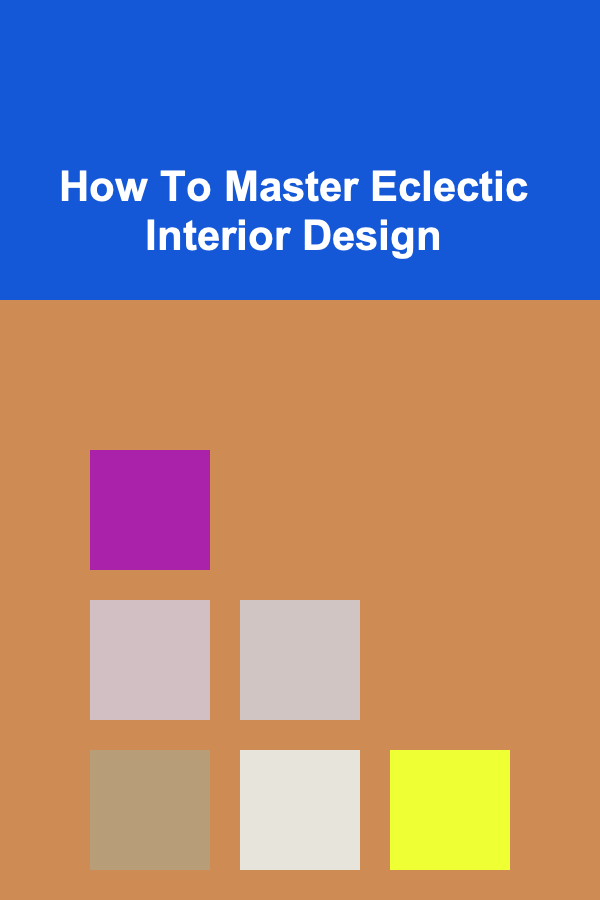
How To Master Eclectic Interior Design
ebook include PDF & Audio bundle (Micro Guide)
$12.99$5.99
Limited Time Offer! Order within the next:

Eclectic interior design is a style that blends various elements from different design periods, cultures, and influences to create a vibrant and personalized space. It is an approach that allows you to combine diverse aesthetics, patterns, colors, and materials in a cohesive way. While it might seem like a random assortment of items, mastering eclectic design requires a thoughtful understanding of the interplay between contrasting styles, textures, and colors.
In this article, we will explore how to master eclectic interior design, discussing key principles, design strategies, and practical tips that can help you create a space that reflects your personality and taste. Whether you are designing a small apartment or a large house, the eclectic style can be adapted to suit any space.
Understanding Eclectic Interior Design
Eclectic design is not about throwing different elements together without rhyme or reason; it is about creating a harmonious blend of various styles. The word "eclectic" itself comes from the Greek word "eklektikos," which means "selective" or "choosing the best." Therefore, eclectic design is about carefully selecting pieces from different time periods, cultures, and design movements and combining them in a way that feels natural and intentional.
The hallmark of eclectic design is its diversity. It is not limited to any one aesthetic, making it incredibly versatile. You might find mid-century modern furniture next to vintage antiques, paired with contemporary art pieces and bohemian textiles. The key is to ensure that despite the varied elements, the space feels unified, not chaotic.
Key Principles of Eclectic Interior Design
Mastering eclectic interior design involves understanding a few core principles that guide the design process. These principles help create a balanced and cohesive space that doesn't feel cluttered or overwhelming.
1. Embrace Color Harmony
One of the most important aspects of eclectic design is color. With so many diverse elements in play, color harmony becomes crucial. Instead of choosing random colors, it's important to establish a color palette that ties everything together.
- Neutral Base: Start with neutral colors like white, gray, or beige for the walls and larger furniture items. Neutral tones provide a calm backdrop for more colorful or patterned items and create a balanced foundation.
- Accent Colors: Once you have your neutral base, introduce vibrant accent colors through smaller accessories like cushions, rugs, curtains, or artwork. You can mix and match bold hues such as emerald green, burnt orange, mustard yellow, or deep blue to create interest and contrast.
- Unified Palette: Even though you are mixing different styles, choosing a consistent color palette throughout the space can help create a sense of unity. Aim for three to five main colors, and use variations of those colors in different tones and shades.
2. Mix Different Styles
The beauty of eclectic design lies in its ability to blend diverse design styles. This might include traditional, modern, industrial, rustic, bohemian, or even minimalist elements. The goal is not to choose one dominant style but to create a space that feels organic and curated by combining different influences.
- Contrast and Balance: While mixing different styles, it's essential to find a balance. For example, a modern sofa might work beautifully with an antique coffee table, but the proportions, colors, and materials must complement each other.
- Furniture and Art: Don't be afraid to place vintage furniture next to contemporary pieces or to use modern artwork alongside traditional sculptures. The key is to create a sense of cohesion through the arrangement and color scheme, ensuring that the contrast between styles adds to the overall aesthetic rather than clashing.
3. Focus on Texture and Materials
Eclectic interior design thrives on texture. Different materials, from velvet and leather to wood and metal, add depth and interest to a space. Combining a variety of textures creates contrast and makes the space feel more inviting and layered.
- Natural Materials: Use wood, stone, and other natural materials for grounding the design. A wooden coffee table, stone fireplace, or woven rug can bring warmth and earthiness to the space.
- Luxurious Fabrics: Incorporate luxurious textures like velvet, silk, or satin through furniture upholstery, cushions, and curtains to create a sense of opulence and sophistication.
- Industrial Elements: Add metallic elements such as brass or chrome for a touch of modern industrial appeal. A metal-framed chair or a brass light fixture can provide an interesting juxtaposition against softer textures like upholstered sofas or woolen throw blankets.
4. Curate Personal and Unique Decor
One of the most appealing aspects of eclectic interior design is that it allows for the display of personal items, unique antiques, and one-of-a-kind treasures. This is a style that celebrates individuality and creativity.
- Art and Antiques: Incorporate art pieces that reflect your personal taste. This could be anything from contemporary art prints to vintage paintings, or even sculptures from your travels. The art should be varied in style, but united by a common theme or color scheme.
- Family Heirlooms: Integrating family heirlooms, such as a grandmother's old mirror or a collection of vintage books, adds a sentimental touch. These items tell a story and help personalize the space.
- Found Objects: Don't hesitate to include unusual or unexpected objects in your decor, like a quirky lamp, a set of antique vases, or a collection of decorative plates. These elements make the space feel more lived-in and reflect your personality.
5. Create Zones and Flow
In an eclectic space, it's important to maintain a sense of flow and organization. Too many contrasting elements in one area can overwhelm the space. Instead, break the room into zones, each with its own distinct feel, but ensure that the transitions between these areas feel smooth.
- Visual Flow: The eye should naturally move from one area to another, guided by a consistent use of colors, textures, or patterns. Use rugs to anchor different zones and tie them together visually.
- Furniture Arrangement: Pay attention to how you arrange furniture to create a sense of openness and flow. Even in an eclectic room, furniture should be arranged in a way that feels functional and comfortable.
- Negative Space: Don't overcrowd the space with too many items. Negative space, or empty space, allows each object in the room to stand out and prevents the design from feeling chaotic.
Practical Tips for Mastering Eclectic Design
1. Start with a Statement Piece
If you're unsure where to begin, start with one statement piece, such as a colorful rug, a bold piece of art, or an antique cabinet. Let this item set the tone for the rest of the room, and build around it. Choose elements that complement or contrast with this piece in a way that feels intentional.
2. Use Layering to Add Depth
Layering is key in eclectic interior design. Mix various elements, such as textures, patterns, and colors, to create a rich and dynamic environment. Layering can be done with textiles like throw blankets and cushions, as well as in furniture arrangement and decorative accessories.
3. Incorporate Greenery
Adding plants and greenery to your eclectic design not only brings a touch of nature indoors but also provides an organic element that balances out the more rigid or industrial elements. Large plants, hanging planters, and succulents all work well in eclectic spaces, adding life and color.
4. Play with Patterns
Eclectic design is all about mixing patterns, so don't be afraid to experiment. Stripes, florals, chevrons, and plaids can all be incorporated into the same space. To keep it from feeling too busy, mix different scale patterns -- for instance, pairing large floral prints with smaller geometric patterns.
5. Embrace Imperfection
Eclectic design is about embracing imperfection and the beauty of lived-in spaces. Instead of aiming for symmetry or perfection, allow the space to feel imperfectly curated. Vintage items, antique furniture, and handmade objects all contribute to this feeling of warmth and individuality.
Conclusion
Mastering eclectic interior design is about finding the right balance between contrast and harmony. It's about creating a space that feels authentic, inviting, and uniquely yours. By understanding the key principles of eclectic design -- from color harmony and texture to mixing different styles -- you can transform any space into a dynamic and personalized environment. Don't be afraid to experiment, layer elements, and showcase your personal style. The beauty of eclectic design lies in its ability to tell a story, blending old and new, tradition and modernity, to create a living space that feels both timeless and contemporary.

How to Create a Simple System for Managing Household Chores
Read More
How to Make Money Online as an Email Marketing Specialist: 10 Actionable Ideas
Read More
How to Organize an Outdoor Movie Night for Your Home Party
Read More
How to Prepare Your Finances for a Big Life Change
Read More
How to Explore Electric Marine Vessels
Read More
How to Use Spreadsheet Software to Track Tax Prep Expenses
Read MoreOther Products

How to Create a Simple System for Managing Household Chores
Read More
How to Make Money Online as an Email Marketing Specialist: 10 Actionable Ideas
Read More
How to Organize an Outdoor Movie Night for Your Home Party
Read More
How to Prepare Your Finances for a Big Life Change
Read More
How to Explore Electric Marine Vessels
Read More